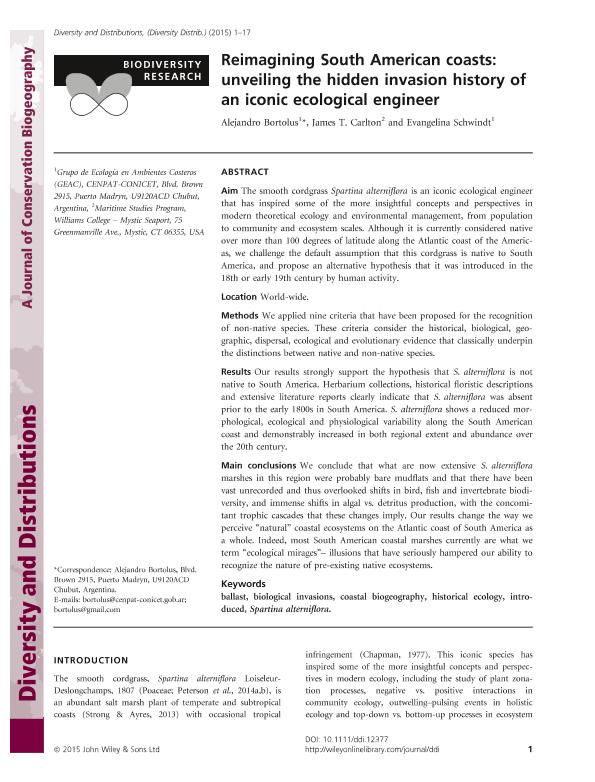Mostrar el registro sencillo del ítem
dc.contributor.author
Bortolus, Alejandro

dc.contributor.author
Carlton, James T.
dc.contributor.author
Schwindt, Evangelina

dc.date.available
2018-02-26T19:11:57Z
dc.date.issued
2015-11
dc.identifier.citation
Bortolus, Alejandro; Carlton, James T.; Schwindt, Evangelina; Reimagining South American coasts: Unveiling the hidden invasion history of an iconic ecological engineer; Wiley Blackwell Publishing, Inc; Diversity and Distributions; 21; 11; 11-2015; 1267-1283
dc.identifier.issn
1366-9516
dc.identifier.uri
http://hdl.handle.net/11336/37146
dc.description.abstract
Aim: The smooth cordgrass Spartina alterniflora is an iconic ecological engineer that has inspired some of the more insightful concepts and perspectives in modern theoretical ecology and environmental management, from population to community and ecosystem scales. Although it is currently considered native over more than 100 degrees of latitude along the Atlantic coast of the Americas, we challenge the default assumption that this cordgrass is native to South America, and propose an alternative hypothesis that it was introduced in the 18th or early 19th century by human activity. Location: World-wide. Methods: We applied nine criteria that have been proposed for the recognition of non-native species. These criteria consider the historical, biological, geographic, dispersal, ecological and evolutionary evidence that classically underpin the distinctions between native and non-native species. Results: Our results strongly support the hypothesis that S. alterniflora is not native to South America. Herbarium collections, historical floristic descriptions and extensive literature reports clearly indicate that S. alterniflora was absent prior to the early 1800s in South America. S. alterniflora shows a reduced morphological, ecological and physiological variability along the South American coast and demonstrably increased in both regional extent and abundance over the 20th century. Main conclusions: We conclude that what are now extensive S. alterniflora marshes in this region were probably bare mudflats and that there have been vast unrecorded and thus overlooked shifts in bird, fish and invertebrate biodiversity, and immense shifts in algal vs. detritus production, with the concomitant trophic cascades that these changes imply. Our results change the way we perceive "natural" coastal ecosystems on the Atlantic coast of South America as a whole. Indeed, most South American coastal marshes currently are what we term "ecological mirages"- illusions that have seriously hampered our ability to recognize the nature of pre-existing native ecosystems.
dc.format
application/pdf
dc.language.iso
eng
dc.publisher
Wiley Blackwell Publishing, Inc

dc.rights
info:eu-repo/semantics/openAccess
dc.rights.uri
https://creativecommons.org/licenses/by-nc-sa/2.5/ar/
dc.subject
Spartina Alterniflora
dc.subject
Ballast
dc.subject
Biological Invasions
dc.subject
Coastal Biogeography
dc.subject
Historical Ecology
dc.subject
Introduced
dc.subject.classification
Otras Ciencias Biológicas

dc.subject.classification
Ciencias Biológicas

dc.subject.classification
CIENCIAS NATURALES Y EXACTAS

dc.title
Reimagining South American coasts: Unveiling the hidden invasion history of an iconic ecological engineer
dc.type
info:eu-repo/semantics/article
dc.type
info:ar-repo/semantics/artículo
dc.type
info:eu-repo/semantics/publishedVersion
dc.date.updated
2018-02-22T14:28:03Z
dc.identifier.eissn
1472-4642
dc.journal.volume
21
dc.journal.number
11
dc.journal.pagination
1267-1283
dc.journal.pais
Reino Unido

dc.journal.ciudad
Londres
dc.description.fil
Fil: Bortolus, Alejandro. Consejo Nacional de Investigaciones Científicas y Técnicas. Centro Nacional Patagónico; Argentina
dc.description.fil
Fil: Carlton, James T.. Maritime Studies Program, Williams College; Estados Unidos
dc.description.fil
Fil: Schwindt, Evangelina. Consejo Nacional de Investigaciones Científicas y Técnicas. Centro Nacional Patagónico; Argentina
dc.journal.title
Diversity and Distributions

dc.relation.alternativeid
info:eu-repo/semantics/altIdentifier/doi/http://dx.doi.org/10.1111/ddi.12377
dc.relation.alternativeid
info:eu-repo/semantics/altIdentifier/url/http://onlinelibrary.wiley.com/doi/10.1111/ddi.12377/abstract
Archivos asociados
